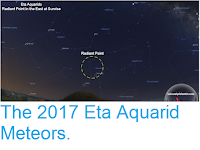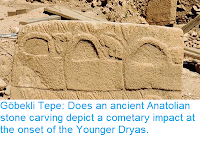Asteroid (448003) 2008 DE passed by the Earth at a distance of about 18 880 000
km (49.1 times the average distance between the Earth and the Moon, or 12.6% of the distance between the Earth and the Sun), slightly after 0.30
am
GMT on Sunday 28 April 2017. There was no danger of
the asteroid hitting us, though were it to do so it would have
presented a considerable threat. (448003) 2008 DE has an estimated
equivalent
diameter of 240-750 m (i.e. it is estimated that a spherical object with
the same volume would be 240-750 m in diameter), and an object of this size would be predicted to be capable of
passing through the Earth's
atmosphere relatively intact, impacting the ground directly with an
explosion that would be 32 000-1 175 000 times as powerful as the
Hiroshima
bomb. Such an impact would result in an impact crater about 3.5-11 km in
diameter
and devastation on a global scale, as well as climatic effects that
would last decades or even centuries.
The calculated orbit of (448003) 2008 DE. Minor Planet Center.
(448003) 2008 DE was discovered on 12 February 2008 by the University of Arizona's Catalina Sky Survey,
which is located in the Catalina Mountains north of Tucson. The
designation 2008 DE implies that it was the fifth asteroid (asteroid E)
discovered in the second half of February 2008 (period 2008 D), while the longer designation (448003) indicates that it was the 448 003rd asteroid discovered
overall (asteroids are not given this longer designation immediately, to
ensure that numbered objects are genuine asteroids that have not been
previously described).
(448003) 2008 DE has an 820 day orbital period and an eccentric orbit
tilted at an angle of 14.8° to the plane of the Solar System, which
takes it from 1.005 AU from the Sun (i.e. 100.5% of he average distance at
which the Earth orbits the Sun) to 2.43 AU from the Sun (i.e. 243% of the
average distance at which the Earth orbits the Sun, and considerably
outside the orbit of the planet Mars). It is therefore
classed as an Amor Group Asteroid (an asteroid which comes close to the
Earth, but which is always outside the Earth's orbit). This means that
close encounters between the asteroid and Earth are fairly common, with
the most recent having occurred in May 2008 next predicted in April 2026. As
an asteroid probably larger than 150 m in diameter that occasionally
comes within 0.05 AU of the Earth, (448003) 2008 DE is also
classified as a Potentially Hazardous Asteroid (it comes no closer to
the Sun than 100.5% of the average distance at which the Earth orbit's the
Sun, but the Earth's orbit is not completely circular).
See also...
Follow Sciency Thoughts on Facebook.







